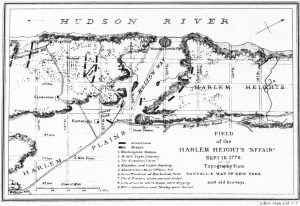As of September 16, 1776, the revolutionary struggle had only resulted in defeat for the Americans. The week before in Boston, September 12 was declared a “day of prayer… on account of the critical state of our military operations.”[1] British ships cruised the East River, General Howe had landed troops in Manhattan the day before, and it was becoming clear that the weakened Continental Army would not hold New York for much longer. Nearly the whole American force had withdrawn to Harlem Heights. However, a victory was finally on the horizon.
After the British landed in the south at Kip’s Bay on the 15th, Washington sent Smallwood’s Marylanders to cover the American retreat from New York City to the line at Harlem. The Maryland regiment remained under arms until nightfall, when they also returned to the American lines.
On the morning of the 16th, Rangers under Lieutenant Colonel Thomas Knowlton discovered the British pickets about a mile below the American line. Knowlton’s men skirmished with the British Light Infantry’s Second and Third Battalions, along with the Forty-second Highlanders, the “Black Watch.” The Americans were outnumbered, with about 120 men against about 400, and Knowlton ordered a retreat.
Word of the engagement reached Washington as the Rangers were retreating back to their lines at Harlem. Washington and much of the American leadership watched the front that morning as Knowlton’s men returned. A number of the pursuing British could be seen from the American camp, and according to Adjutant-General Joseph Reed, the British buglers sounded a foxhunt call as they chased the retreating Rangers, halting at the Bloomingdale Heights. “I never felt such a sensation before, it seemed to crown our disgrace,” Reed wrote of the bugles.
The boldness of the British chase had separated them from the main army, giving the Americans a chance at their first victory. General Washington began setting a trap to take the isolated troops prisoner. He would first attack their front, while a flanking party would quietly assemble to their rear and prevent their escape.
The maneuver was executed nearly as planned. However, instead of attacking from the rear, the flanking party fired on the British side, which left open a route of escape. The British, realizing they had been nearly surrounded, began to run back up the slope of Bloomingdale Heights. The Americans gave chase “with splendid spirit and animation.”[2]
General Howe could hear the firing from his headquarters and sent reinforcements as well as two field pieces to aid the British. With the enemy on the run, Washington sent out three of the Maryland Independent companies and parts of the Maryland Flying Camp, who had recently arrived in New York. The Americans drove the British down from the Bloomingdale Heights to a field of buckwheat, where the smaller British contingent met with their reinforcements and took a stand. However, the Americans pressed on and pushed them further back. After fighting the British back towards their encampment, Washington, whose men were not prepared to engage all of the troops situated in the British camp, sent out the order to withdraw.
The prisoners the Americans took that day would say that “they expected our Men would have run away as they did the day before, but they were never more surprised than to see us advancing to attack them.”[3]
The Marylanders especially gained recognition for their participation in the battle of Harlem Heights. A letter from the camp to Annapolis recounted that “General Washington gave great applause to our Maryland troops, for their gallant behaviour.”[4] Lieutenant Tench Tilghman, a Marylander who was Washington’s aide-de-camp and Secretary, would write that the Maryland and Virginia troops “bear the Palm.”
The Continental Army had its first lesson in victory. The Americans cheered before leaving the battlefield to return to Harlem Heights. Lieutenant Tilghman wrote of the improved morale, “on the whole the enemy got completely defeated, which has given great spirits to our army, who are… in high spirits, wailing the attack of the enemy.”[5]
The experience galvanized the revolutionary troops, who had suffered relentless losses over the preceding weeks, and would have to bear more defeats in the coming months.
[1] Day of prayer appointed at Boston, American Archives Online, September 12, 1776, Series 5, Vol. 2, Pg. 307.
[2]Henry P. Johnston, The Campaign of 1776 Around New York and Brooklyn, New York: Da Capo Press, 1971, 256.
[3] Lieut. Tench Tilghman to his father, Philadelphia, September 19, 1776, in Johnston, The Campaign of 1776, 87.
[4]Extract of a letter from Head-Quarters to a gentleman in Annapolis: Shall give the enemy a genteel drubbing in case the Yankees will fight, September 17, 1776, American Archives Online, Series 5, Vol. 2, Pg. 370.
[5] Extract of a letter from a General Officer who was present at the action on the 16th of September, American Archives Online, September 23, 1776, Series 5, Vol. 2, Pg. 371.
-Emily





I have an original map very similar to this one
LikeLike
Very cool! This map came from The Campaign of 1776 Around New York and Brooklyn by Henry Phelps Johnston (1878), which is available online. Johnston’s maps and info on the geography of the battle are great.
LikeLike
Pingback: Welcome to Finding the Maryland 400 | Finding the Maryland 400